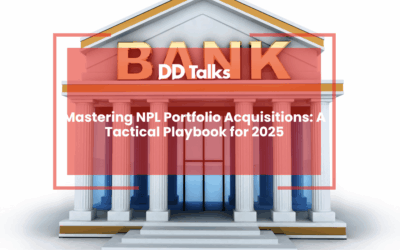Essential Insights for NPL Securitization Success
- NPL securitization offers dual benefits of immediate liquidity and regulatory capital relief, enabling banks to transform distressed assets into marketable securities while optimizing balance sheets.
- Effective structuring through senior, mezzanine, and junior tranches creates tailored risk-return profiles that appeal to different investor classes while implementing critical credit enhancement mechanisms.
- Successful risk transfer requires careful consideration of true sale versus synthetic structures, with regulatory recognition dependent on demonstrating substantial risk movement to third parties.
- Rating agency methodologies for NPL securitizations focus primarily on recovery analysis rather than default probability, with particular emphasis on servicer capabilities and jurisdiction-specific legal frameworks.
- Comprehensive deleveraging strategies combine portfolio segmentation, strategic timing, expert servicing, and robust data management to optimize NPL resolution outcomes.
- Future evolution of European NPL markets will be shaped by increasing standardization, technological innovation, ESG considerations, and a broadening investor ecosystem.
Table of Contents
- Understanding NPL Securitization Fundamentals and Benefits
- How Does the NPL Securitization Process Work?
- Structuring NPL Asset-Backed Securities: Key Components
- NPL Risk Transfer Mechanisms for Effective Capital Relief
- Rating Agency Methodologies in NPL Securitization Deals
- Implementing Successful NPL Deleveraging Strategies
- Navigating Regulatory Challenges in European NPL Markets
- Future Trends: Evolution of NPL Securitization in Europe
Understanding NPL Securitization Fundamentals and Benefits
NPL securitization represents a sophisticated financial mechanism that enables banks to transform non-performing loan portfolios into marketable securities. At its core, this process involves pooling diverse non-performing loans, structuring them into tranches with varying risk profiles, and selling these securities to investors. The fundamental appeal of NPL securitization lies in its dual capacity to generate immediate liquidity while simultaneously providing regulatory capital relief.
For European banks grappling with elevated NPL ratios, securitization offers a strategic pathway to balance sheet optimisation without necessitating outright loan sales at potentially steep discounts. The benefits extend beyond immediate financial relief. By transferring NPL risk to capital markets, banks can redirect resources toward core lending activities, enhance overall financial stability, and improve key performance metrics that influence investor confidence and regulatory assessments.
NPL securitization also creates a structured investment opportunity for specialised investors seeking exposure to distressed assets with potentially attractive risk-adjusted returns. This market-based approach to NPL management has gained significant traction across Europe, particularly in markets like Italy, Spain, and Greece, where the GACS scheme and similar government-supported programmes have catalysed transaction volumes.
How Does the NPL Securitization Process Work?
The NPL securitization process follows a structured sequence that transforms problematic loans into marketable securities. Initially, banks conduct comprehensive portfolio analysis to identify suitable NPL pools, evaluating factors such as loan vintage, collateral quality, borrower profiles, and recovery prospects. This due diligence phase is critical for accurate valuation and appropriate structuring decisions.
Once the portfolio is defined, the originating bank establishes a Special Purpose Vehicle (SPV) – a legally separate entity that purchases the NPL portfolio. This transfer can occur through true sale transactions, where legal ownership shifts entirely to the SPV, or synthetic structures, where economic risk transfers while loans remain on the bank’s balance sheet. The SPV then issues asset-backed securities (ABS) to investors, with proceeds funding the NPL acquisition.
A distinctive feature of the NPL securitization process is the appointment of specialised servicers responsible for loan recovery activities. These servicers implement tailored workout strategies to maximise collections from the underlying distressed assets. Their performance directly impacts the cash flows available to security holders, making servicer selection and oversight crucial elements in transaction design.
Throughout the process, detailed documentation establishes the legal framework, cash flow waterfall, reporting requirements, and governance mechanisms. This documentation provides transparency and certainty for all transaction participants while addressing the complex legal considerations inherent in transferring distressed debt obligations.
Structuring NPL Asset-Backed Securities: Key Components
The architecture of NPL asset-backed securities involves sophisticated structuring to allocate risk and return among different investor classes. The cornerstone of this structure is tranching – the creation of hierarchical security classes with distinct priority claims on cash flows. Typically, NPL securitizations feature senior, mezzanine, and junior tranches, each with specific risk-return profiles tailored to different investor appetites.
Senior tranches offer the highest payment priority and lowest risk, attracting risk-averse institutional investors seeking stable returns. Mezzanine tranches occupy the middle ground, providing enhanced yields with moderate risk exposure. Junior tranches (sometimes called equity tranches) absorb first losses but offer the highest potential returns, appealing to specialised distressed debt investors and occasionally retained by the originating bank as skin in the game.
Credit enhancement mechanisms represent another vital component in NPL ABS structuring. These include overcollateralization (where the face value of underlying assets exceeds the securities issued), reserve accounts that capture excess spread, and performance-based triggers that redirect cash flows if collection metrics deteriorate. These safeguards provide structural protection for senior investors while creating the risk differentiation necessary for market placement.
The cash flow waterfall – the contractual framework governing how collections from the NPL portfolio are distributed – establishes payment priorities, reserve requirements, and performance incentives for servicers. This carefully calibrated mechanism ensures orderly distribution of recoveries while maintaining alignment between servicer motivation and investor interests. The evolution of securitisation structures continues to introduce innovations that address the unique challenges of NPL portfolios.
NPL Risk Transfer Mechanisms for Effective Capital Relief
Effective NPL risk transfer represents the cornerstone of successful capital relief transactions. Banks employ two primary mechanisms to achieve this objective: traditional (true sale) securitizations and synthetic structures. In true sale transactions, the physical transfer of NPL assets to the SPV creates clean risk separation, removing the assets entirely from the originator’s balance sheet. This approach delivers comprehensive capital relief but requires addressing complex legal considerations regarding asset transfer and servicing arrangements.
Synthetic securitizations, by contrast, utilise credit derivatives or guarantees to transfer economic risk while maintaining the loans on the bank’s balance sheet. This approach offers operational simplicity and avoids some of the legal complexities of true sales. However, it requires careful structuring to ensure regulatory recognition of risk transfer. Significant Risk Transfer (SRT) assessments by regulators evaluate whether sufficient risk has genuinely moved to external investors to justify capital relief.
The effectiveness of these risk transfer mechanisms depends on several critical factors. Transaction structuring must demonstrate substantial risk movement to third parties, typically requiring the transfer of first-loss positions and meaningful portions of mezzanine risk. Regulatory capital calculations must properly account for any retained exposures, servicing arrangements, and implicit support considerations. Additionally, the economic substance of the transaction must align with its legal form to withstand regulatory scrutiny.
When properly executed, these risk transfer mechanisms can dramatically improve a bank’s capital ratios by reducing risk-weighted assets associated with NPL portfolios. This capital efficiency creates financial flexibility for new lending activities while maintaining regulatory compliance – a particularly valuable outcome in Europe’s stringent regulatory environment.
Rating Agency Methodologies in NPL Securitization Deals
Rating agencies play a pivotal role in NPL securitization markets by providing independent assessments that influence investor confidence and pricing dynamics. Their methodologies for evaluating NPL-backed securities incorporate specialised analytical frameworks that differ significantly from those applied to performing loan securitizations. These approaches focus intensively on recovery analysis rather than default probability, reflecting the already-defaulted status of the underlying assets.
When analysing NPL securitizations, rating agencies conduct granular assessments of collateral quality, historical recovery rates, and liquidation timelines. They evaluate the legal environment governing foreclosure and collection processes, which varies substantially across European jurisdictions. Servicer capabilities receive particular scrutiny, with detailed evaluation of operational resources, workout strategies, and historical performance metrics in managing similar distressed assets.
Cash flow modelling represents another critical component of rating methodologies. Agencies stress-test transaction structures against various recovery scenarios, timing assumptions, and macroeconomic conditions. These simulations evaluate whether each tranche can withstand adverse scenarios consistent with its target rating level. The analysis incorporates structural features like reserve funds, excess spread mechanisms, and performance triggers that influence cash flow distribution.
Rating stability considerations also factor prominently in agency methodologies. Given the inherent volatility in NPL recoveries, agencies typically apply more conservative assumptions and higher credit enhancement requirements than for performing loan securitizations. This conservative approach helps mitigate rating volatility but can impact transaction economics, creating a delicate balance between rating objectives and commercial viability.
Implementing Successful NPL Deleveraging Strategies
Successful NPL deleveraging requires a strategic approach that extends beyond individual securitization transactions to encompass comprehensive portfolio management. Banks achieving the most effective results typically implement multi-faceted strategies that combine securitization with other complementary approaches. These integrated strategies begin with portfolio segmentation – categorising NPLs based on asset type, vintage, collateral quality, and recovery prospects to identify optimal resolution paths for different loan clusters.
Timing considerations significantly influence deleveraging outcomes. Banks must balance the urgency of NPL reduction against market conditions affecting execution pricing. Phased approaches often prove advantageous, addressing higher-quality NPLs through initial securitizations while developing enhanced workout capabilities for more challenging assets. This sequenced strategy can demonstrate positive momentum to regulators and investors while building institutional expertise.
Servicer selection and management represent critical success factors in NPL deleveraging. Whether utilising internal servicing units or external specialists, establishing robust performance metrics, incentive structures, and oversight mechanisms ensures alignment with overall deleveraging objectives. Leading institutions develop collaborative relationships with servicers that facilitate information sharing, strategy refinement, and continuous process improvement.
Data quality underpins all successful deleveraging initiatives. Comprehensive loan-level information, accurate collateral valuations, and detailed borrower profiles enable precise portfolio valuation and appropriate structuring decisions. Investments in data remediation and management systems often yield substantial returns through improved execution pricing and investor confidence. This data-centric approach supports not only securitization but all potential NPL resolution strategies.
Navigating Regulatory Challenges in European NPL Markets
The European regulatory landscape for NPL securitization presents a complex terrain that transaction participants must navigate carefully. The intersection of securitization regulations, banking prudential requirements, and NPL-specific directives creates a multifaceted compliance framework. The EU Securitisation Regulation establishes baseline requirements for all securitizations, including risk retention, transparency, and due diligence obligations. For NPL transactions, these requirements incorporate specific adaptations recognising the unique characteristics of distressed assets.
Capital treatment considerations represent a primary regulatory challenge. Banks must demonstrate Significant Risk Transfer (SRT) to achieve capital relief, requiring detailed analysis of risk distribution across tranches. Regulatory authorities apply increasingly stringent assessments of whether economic substance aligns with the stated capital objectives. These evaluations examine retained interests, structural features, and any implicit support arrangements that might undermine genuine risk transfer.
Accounting treatment introduces additional complexity, particularly regarding derecognition criteria under IFRS 9. The interaction between accounting standards and regulatory capital rules can create situations where transactions achieve regulatory capital relief without accounting derecognition, or vice versa. This divergence necessitates careful transaction structuring to optimise both dimensions.
Country-specific regulatory frameworks add another layer of complexity. National schemes like Italy’s GACS programme provide government guarantees for senior tranches of NPL securitizations, enhancing marketability while imposing specific structural requirements. These national initiatives operate within the broader European framework but introduce unique considerations regarding guarantee mechanisms, eligible assets, and reporting obligations. Successful navigation of these regulatory challenges requires specialised expertise and proactive engagement with relevant authorities.
Future Trends: Evolution of NPL Securitization in Europe
The European NPL securitization landscape continues to evolve, shaped by market dynamics, regulatory developments, and technological innovation. Several emerging trends signal the future direction of this market. First, we observe increasing standardisation of transaction structures and documentation, facilitating greater market liquidity and investor participation. Industry initiatives to establish common data templates, performance metrics, and reporting frameworks are reducing information asymmetries and transaction costs.
Technological advancements are transforming NPL management capabilities. Advanced analytics, machine learning algorithms, and digital platforms enable more sophisticated portfolio segmentation, valuation modelling, and recovery strategies. These technologies enhance servicer efficiency while providing investors with greater transparency and performance visibility. Digital solutions for borrower engagement and restructuring are also improving recovery outcomes in certain asset classes.
ESG considerations are gaining prominence in NPL markets. Social factors, particularly regarding borrower treatment and restructuring approaches, are influencing transaction design and servicer selection. Environmental factors affect collateral valuation and liquidation strategies, especially for commercial real estate assets. Governance aspects, including transparency and alignment of interests, are receiving heightened attention from both investors and regulators.
The investor base for NPL securitizations continues to broaden and specialise. While traditional distressed debt investors remain active, we see increasing participation from institutional investors seeking diversification and yield enhancement. Specialised credit funds with asset-specific expertise are developing targeted strategies for particular NPL segments. This evolving investor ecosystem is creating more nuanced pricing and greater market depth, supporting larger and more complex transactions. As European banks continue addressing legacy NPL positions and preparing for potential new distressed cycles, these trends will shape the next generation of NPL securitization practices.
Frequently Asked Questions
What is NPL securitization and how does it benefit banks?
NPL securitization is a financial mechanism that transforms non-performing loan portfolios into marketable securities by pooling loans, structuring them into risk-based tranches, and selling them to investors. The primary benefits for banks include immediate liquidity generation, regulatory capital relief, balance sheet optimization without steep discount loan sales, redirection of resources toward core lending activities, enhanced financial stability, and improved performance metrics that influence investor confidence.
What are the key components of NPL securitization structures?
The key components include: 1) Tranching – creating hierarchical security classes (senior, mezzanine, and junior) with distinct priority claims on cash flows; 2) Credit enhancement mechanisms – overcollateralization, reserve accounts, and performance-based triggers; 3) Cash flow waterfall – the contractual framework governing how collections are distributed; 4) Special Purpose Vehicle (SPV) – the legally separate entity that purchases the NPL portfolio; and 5) Specialized servicers responsible for loan recovery activities.
How do true sale and synthetic securitizations differ in NPL transactions?
In true sale securitizations, NPL assets are physically transferred to an SPV, creating clean risk separation and removing assets entirely from the originator’s balance sheet, providing comprehensive capital relief but requiring complex legal considerations. Synthetic securitizations use credit derivatives or guarantees to transfer economic risk while maintaining loans on the bank’s balance sheet, offering operational simplicity but requiring careful structuring to ensure regulatory recognition of risk transfer through Significant Risk Transfer (SRT) assessments.
What factors do rating agencies consider when evaluating NPL securitizations?
Rating agencies focus on recovery analysis rather than default probability, conducting granular assessments of collateral quality, historical recovery rates, and liquidation timelines. They evaluate the legal environment governing foreclosure processes, servicer capabilities and track records, cash flow modeling under various stress scenarios, structural features like reserve funds, and apply conservative assumptions to mitigate rating volatility given the inherent unpredictability in NPL recoveries.
What regulatory challenges exist in European NPL securitization markets?
Key regulatory challenges include: 1) Compliance with EU Securitisation Regulation requirements for risk retention, transparency, and due diligence; 2) Demonstrating Significant Risk Transfer (SRT) to achieve capital relief; 3) Navigating accounting treatment under IFRS 9, particularly regarding derecognition criteria; 4) Addressing country-specific regulatory frameworks like Italy’s GACS programme; and 5) Managing the intersection of securitization regulations, banking prudential requirements, and NPL-specific directives.
How is technology changing NPL securitization practices?
Technology is transforming NPL management through advanced analytics, machine learning algorithms, and digital platforms that enable more sophisticated portfolio segmentation, valuation modeling, and recovery strategies. These technologies enhance servicer efficiency, provide investors with greater transparency and performance visibility, improve borrower engagement through digital solutions, and support more accurate pricing models. Data management systems are particularly crucial for enabling precise portfolio valuation and appropriate structuring decisions.




0 Comments